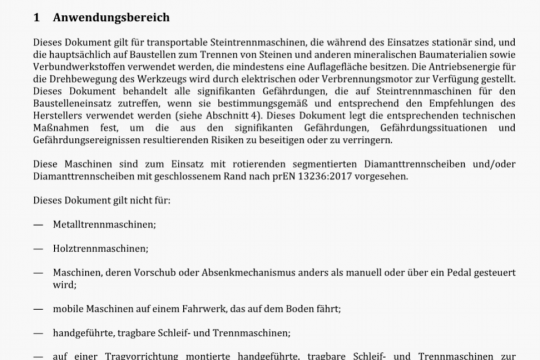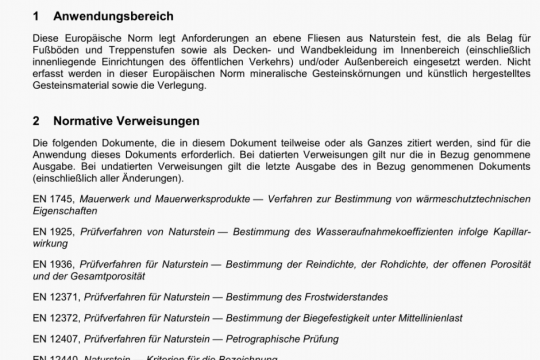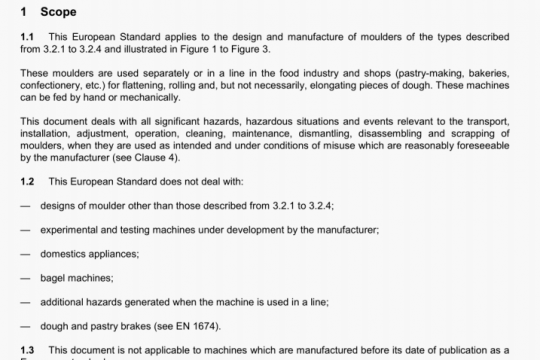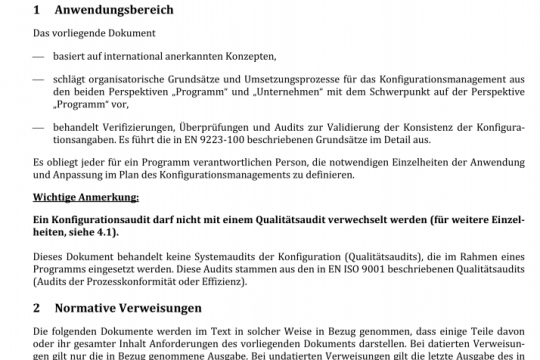DIN EN 12268 pdf free download
DIN EN 12268-2015 pdf free download.Nahrungsmittelmaschinen – Bandsagemaschinen一 Sicherheits- und Hygieneanforderungen; Englische Fassung EN 12268:2014, Englische Ubersetzung von DIN EN 12268:2015-01.
5 Safety requirements andlor measures
5.1 General
Band-saw machines shall comply with the safety requirements and/or protective measures of this clause.
In addition, they shall be designed according to the principles of EN ISO 12100 for hazards relevant but not significant, which are not dealt with by this document.
Where the means of reducing the risk is by the physical arrangement or positioning of the installed band-saw machine, the manufacturer shall include in the Information for use a reference to the reduction means to be provided, and to any limiting value of the requirement, and, if appropriate, to the means of verification.
The safety related parts of the control system shall present at least a performance level “c in accordance with
EN ISO 13849-1:2008.
For specific intended use and/or applications some examples for work aid tools with a protective function are given in Annex C.
5.2 Mechanical hazards
5.2.1 General
Saw blades shall be removed periodically. Saw blades are sharp and special measures shall be taken. For such blades, designers shall provide means of attaching a tool to the blade to avoid hand contact and a box, or surround guard, to protect against the sharp edges of the blade during handling and transportation. Explanations on the use of these protective means shall be included in the instructions for use.
The interlocking system for movable guards shall be built inside of the machine housing and shall comply with EN ISO 14119:2013, 4.2 and Clause 7.
In general band saw machines do not require an emergency stop device. If no emergency stop device is fitted, the normal OFF-switch shall be easily reachable from the operator position (see Figure 1 and Figure 2) and shall be protected against unintentional switch-on (e.g. by a protective collar).
Cutting tool handling: cutting tools shall be removed periodically. Cutting tools are sharp and special measures shall be taken. For such blades, designers shall provide means of attaching a tool to the blade to avoid hand contact and a box, or surround guard, to protect against the sharp edges of the blade during handling and transportation. Explanations on the use of these protective means shall be included in the instructions for use.
Verification: Visual inspection of the machine and its documentation.
5.2.2 Saw blade protection outside of the cutting zone — Zone I
Access to the saw blade outside the cutting zone shall be prevented. This can be achieved e.g. by the following measures:
A closed machine casing shall be provided. The doors of the casing and the removable or tiltable feed table shall be interlocked.
Fixing systems for fixed guards or for demountable parts of the machine casing (i.e. designed as fixed guards) shall remain attached to the guards or to the machine when the guards are removed.
For requirements relating to the interlocking system of doors and the feeding table, see 5.2.1.
After opening the door or the feed table more than 10 mm, the blade shall come to a standstill as soon as is
possible, but the time taken shall not exceed 4 s.
5.2.3 Protection at the cutting zone — Zone 2
5.2.3.1 Type A
Access to the cutting zone of the saw blade shall be prevented. This can be achieved e.g. by the following measures:
A non-detachable, movable product pusher shall be provided. The product pusher shall be designed so as to automatically revert to its protective position by its own weight. Distance Al between the product pusher and the non-detachable feed table shall be 6 mm. Design example, see section A — A. Figure 7.
A horizontal adjustable portioning plate of a height > 60 mm shall be provided. The portioning plate may be designed to be tiltable and removable.
It shall be possible to change the saw blade without removing the product pusher.DIN EN 12268 pdf download.




